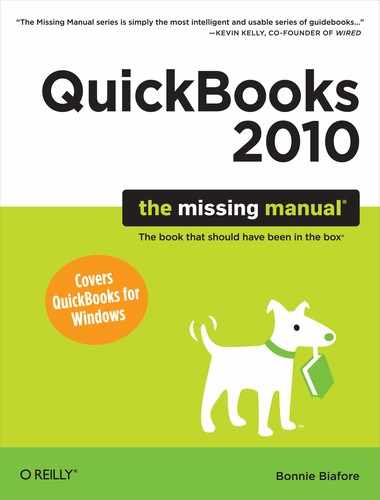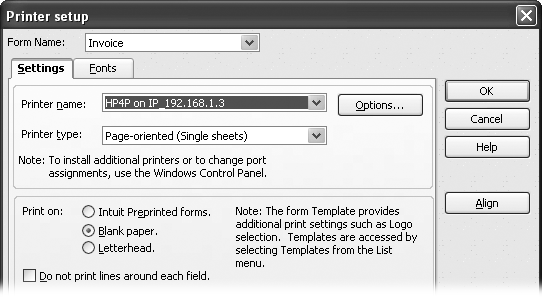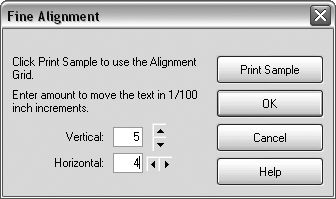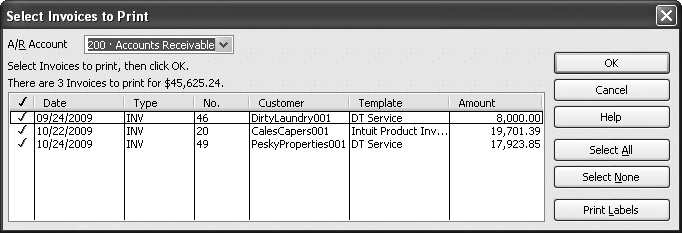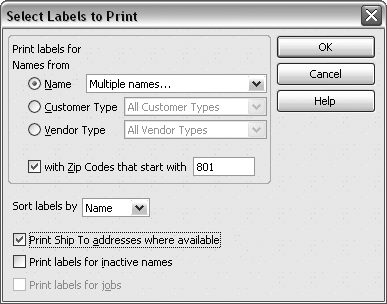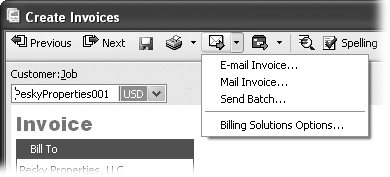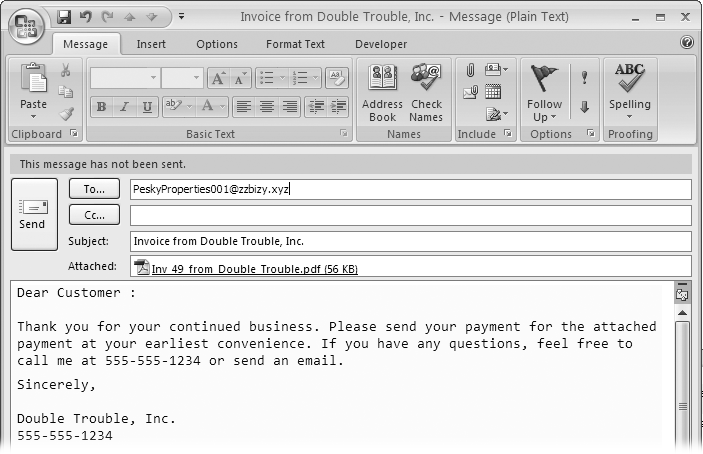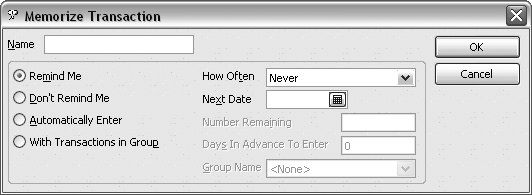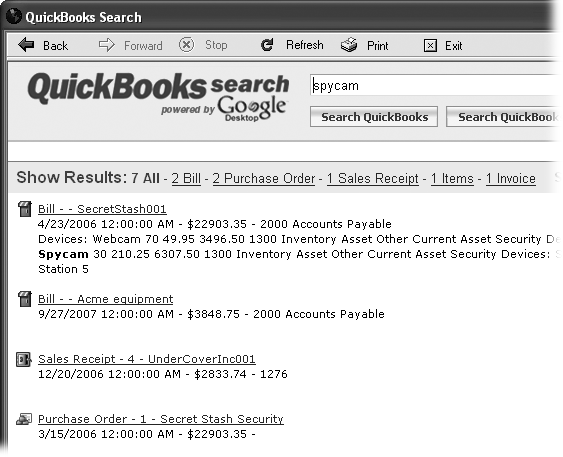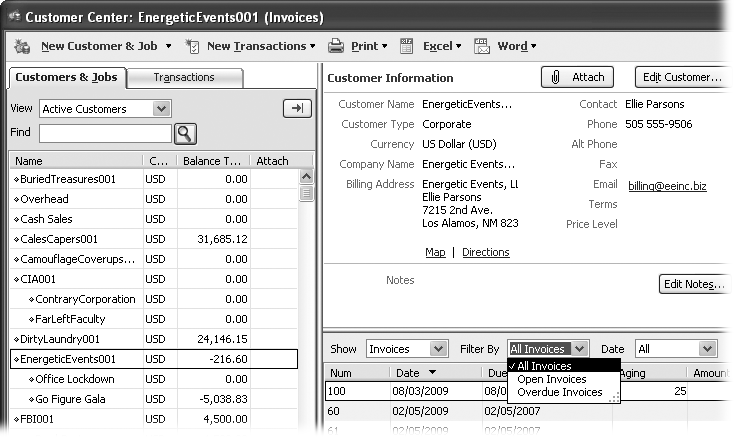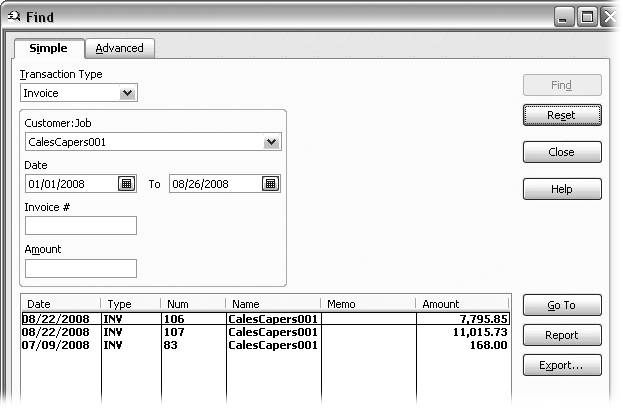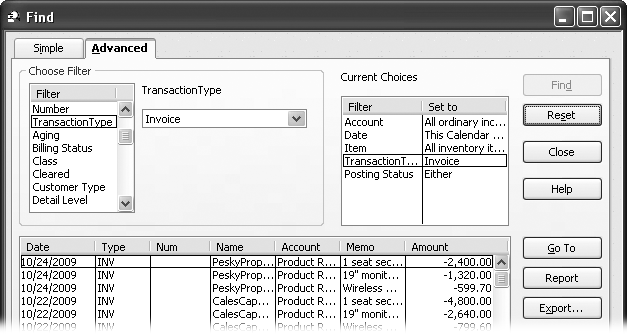Chapter 12. Transaction Timesavers
QuickBooks can zip you through the two basic ways you distribute your invoices and other sales forms: on paper and electronically. But within those two distribution camps, you can choose to send your forms as soon as you’ve completed them or place them in a queue to send in batches. For sporadic sales forms, it’s easier to print or email them as you go. But when you generate dozens or even hundreds of sales orders, invoices, or statements, printing and emailing batches is a much better use of your time.
When you have workhorse transactions that you enter again and again, QuickBooks can memorize them and then fill in most, if not all, of the fields in future transactions for you. For transactions that happen on a regular schedule—like monthly customer invoices or vendor bills—the program can remind you when it’s time to record a transaction, or add the transaction without any help from you. But you can also memorize transactions that you use occasionally, such as estimates, and call on them only when you need them.
QuickBooks’ search features can also save you time, which you can appreciate if you’ve ever hunted frantically for a transaction. Whether you want to correct a billing problem on a customer invoice, check whether you paid a vendor’s bill, or look for the item you want to add to an estimate, QuickBooks gives you several ways to search: You can look for different types of transactions within various date ranges in the Customer, Vendor, and Employee Centers. The Item List window sports a few search boxes for finding the items you want. On the other hand, the Find command is perfect for surgical searches. And Google search fans can install Google Desktop and use its magical powers to find anything in QuickBooks and the rest of your computer.
Printing Sales Forms
Before you start printing, you have some setup to do. But once QuickBooks’ print settings are in place and there’s paper in your printer, you can print forms with a click or two. For each type of form you print, QuickBooks wants to know the printer you want to use, the paper you print to (like preprinted forms or letterhead), and a few other details. The program remembers these settings, so you have to go through this process only once. From then on, QuickBooks fills the settings in automatically in the Print dialog box, but you can change them before you print if you want.
With these prep tasks behind you, you’re ready to print. In QuickBooks, you can print a form right away or add it to a queue to print in batches. This section explains how to accomplish all these printing tasks.
Tip
If you want to make sure you don’t forget to send your sales forms, you can create reminders (see Reminders) for invoices, credit memos, sales receipts, and, if you use QuickBooks Premier or Enterprise, sales orders, that are queued up to print.
Setting Print Options
Many of the printer options in the “Printer setup” dialog box are the same as options you can set within your operating system, as you’ll see in Figure 12-1. To assign and set up printers for forms in QuickBooks, choose File → Printer Setup. Then, choose the following settings:
Form Name. You’re free to print your invoices to your letterhead, timesheets in landscape orientation, and checks to a printer filled with preprinted checks. In QuickBooks, each form has its own print settings. In the Form Name drop-down list, choose the form you want to set up for printing.
Printer name. Choose a printer to anoint as the standard for the form you selected (see the box on Setting Print Options). When you’re printing forms, QuickBooks automatically selects this printer, but you can choose a different printer (Printing One Form)—for instance, when you switch between printing paper documents and creating Adobe .pdf files that you can email.
Options. If you want to adjust the properties for the printer you chose, click Options. Depending on the type of printer, in the printer Document Properties dialog box, you can change the document orientation, page order, pages per sheet, print quality, paper tray, color, and so on.
Printer type. This setting and the others that follow in this list appear for most of the forms in the Form Name drop-down list, but not when you select Report or Graph. When you choose a printer name, QuickBooks fills in the “Printer type” box with its best guess of the type (and usually guesses right). If QuickBooks guesses wrong, simply choose the correct type in the drop-down list. If the printer feeds individual pages through, such as letterhead or blank paper, choose “Page-oriented (Single sheets)”. If a printer feeds continuous sheets of paper with perforations on the edges, such as the green-striped paper so popular in the past, choose “Continuous (Perforated Edge)”.
Intuit preprinted forms. If you purchase preprinted forms, which typically include your company information, field labels, and lines that separate fields, choose this option. When you print your documents, QuickBooks sends only the data to fill in the form.
Blank paper. This option tells QuickBooks to print everything on your document template: company information, logo, labels, and data. This is also the easiest way to print because you don’t have to worry about aligning the paper and the form. If you set up a template with your company logo and attractive fonts (Basic Customization), you can produce a professional-looking form on blank paper.
Letterhead. When you print to letterhead that already includes your company address and other information, you don’t need to print that information on your documents. Choose this option to suppress the printing of your company information.
Do not print lines around each field. Turning on this checkbox is a matter of personal preference. Lines around each field make it clear which information belongs to which label, but you might consider those lines unnecessary clutter. If your template separates fields to your satisfaction, turn off this checkbox to print only the labels and data, not borders around each field. Because preprinted forms include borders, QuickBooks automatically turns on this checkbox if you choose the “Intuit preprinted forms” option.
Aligning Forms and Paper
If you’ve ever gotten lost at your office supply store, you understand why printing includes so many options. You can print on different types of paper using different types of printers, and making the two line up properly can be a delicate process. Besides the invoices and other sales forms themselves, you might print ancillary documents like mailing labels and packing slips.
To save some trees and your sanity, make sure that the paper in your printer is aligned properly before you print, especially if you print to fancy letterhead or preprinted forms. When you use preprinted forms or continuous-feed paper with perforations for page breaks, the alignment of the paper is crucial. Otherwise, your data won’t appear next to the correct labels or an invoice might print over the page break. It’s a good idea to check the alignment of your forms and paper every time you print, but it’s particularly important if you’re printing a batch of documents. There’s no faster way to waste time and paper than printing a big stack of invoices that don’t line up with your expensive letterhead or preprinted forms. Here’s how to save time, paper, and your mental health:
Choose File → Print Forms, and then choose the type of form you want to print.
Select the forms you want to print and click OK to open the Print <form> dialog box, such as Print Invoices if you’re printing invoices.
Note
You can align your form to printer paper in the “Printer setup” dialog box; click Align. As long as you don’t move the paper in the printer, you won’t have to align the paper each time you print. However, if someone else monkeys with the printer, you can align the form from the Print dialog box.
To align your form to the paper, in the Print dialog box, click Align.
If you have more than one template to choose from, QuickBooks opens the Align Printer dialog box.
Choose the template you want to use to align your paper, and then click OK.
If you’re printing to a page-oriented printer, QuickBooks displays the Fine Alignment dialog box, described in step 4.
If you’re using a continuous-feed printer, your first step is a coarse alignment: Position the paper so the print head is just below a page break, click Coarse, and then click OK to print a sample form. Don’t adjust the paper in your printer (QuickBooks warns you several times not to). The form that prints includes text indicating a pointer line. When the Coarse Alignment dialog box appears, in the Pointer Line Position box, type the number of the line preprinted in the paper margin. QuickBooks uses that line number to align the form and the paper. Click OK to print another sample. When the alignment is correct, click Close. You can then perform a fine alignment if necessary.
In the Fine Alignment dialog box, shown in Figure 12-2, in the Vertical and Horizontal boxes, type numbers to represent the hundredths of an inch to move the form to line it up with the paper.
After you tweak the alignment, click Print Sample to check the printed form’s appearance. When the form is aligned, click OK—and keep your mitts off the paper in the printer.
Choosing a Print Method
Each type of sales form in QuickBooks gives you the same basic methods and options for printing documents on the Print drop-down menu, shown in the Create Invoices window in Figure 12-3.
Here’s a guide to your choices for printing documents:
Print one form. If you want to print the current form, in the form window’s icon bar, click the Print icon. If you click the down arrow to the right of the Print icon, you can choose any of the print commands from the drop-down list. For instance, you can preview the form you’re about to print, print the current form, print all the forms in your queue, or print special forms such as packing slips.
Printing in batches. When you turn on the “To be printed” checkbox (below the line-item table in the window), QuickBooks adds the current form to a queue of forms that you’ll print as a batch.
Printing One Form
When you display a form in its corresponding window, you can preview and print it right away. For example, in the Create Invoices window, to print the displayed invoice, click the Print icon or click the down arrow next to the Print icon and then choose Preview or Print. You’ll see the Print One Invoice dialog box, where you can choose the printer and paper.
Printing in Batches
When you turn on the “To be printed” checkbox before you save a form, QuickBooks adds that form to a print queue. After you’ve checked that your printer contains the correct paper and that the paper is aligned properly, you can print all the forms in the queue in just a few steps:
Choose File → Print Forms and then choose the type of forms you want to print. (Or, in the form window, like Create Invoices, for example, click the down arrow to the right of the Print icon and then choose Print Batch.)
QuickBooks opens the “Select <type of form> to Print” dialog box with all unprinted forms selected, as shown in Figure 12-4.
Click OK to print the selected forms in the queue.
QuickBooks anticipates the problems that can happen during printing (paper jams, low toner, or smears). After the program prints the forms, it opens the “Print <type of form> - Confirmation” dialog box.
If a problem occurred, in the “Print <type of form> - Confirmation” dialog box, click the Reprint cell for each form that didn’t print correctly.
If the whole batch is a loss, click Select All.
Click OK to reprint the forms.
Printing Mailing and Shipping Labels
QuickBooks can print mailing labels to go with the forms you print. Because the program prints labels for the customers selected in the “Select <type of form> to Print” dialog box, you have to print the labels before you print the forms. Here’s how:
Choose File → Print Forms, and then choose the type of forms for which you want labels.
QuickBooks opens the “Select <type of form> to Print” dialog box with all unprinted forms selected.
If you want to print labels for a mailing without an associated sales form (like an open house announcement) choose File → Print Forms → Labels
In the “Select <type of form> to Print” dialog box, click Print Labels.
QuickBooks opens the “Select Labels to Print” dialog box and automatically chooses the Name option, which prints labels for the customers or vendors associated with each form waiting to print.
If you’ve created forms for a specific customer type or vendor type, choose the Customer Type or Vendor Type option and, in the drop-down list, choose the type you want to print labels for.
These options are better suited for printing labels not associated with your queued forms—for example, when you want to send a letter to your retail customers informing them of product rebates. Or you might use them if you process forms for retail and wholesale customers at different times of the month.
To filter the printed labels by location, turn on the “with Zip Codes that start with” checkbox, and type the beginning of the Zip code area you want, as shown in Figure 12-5.
For example, if you’re offering a seminar for people in the Denver area, you can type 801 in the box.
In the “Sort labels by” box, choose Name or Zip Code.
If you use bulk mail, choose Zip Code so you can bundle your mail by Zip code as your bulk mail permit requires.
If you want to print shipping labels rather than labels that use billing addresses, turn on the “Print Ship To addresses where available” checkbox.
The “Print labels for inactive names” checkbox might develop some cobwebs, but it can come in handy from time to time—for instance, if you need to send a letter to past and present customers to tell them about a product recall.
When you send communication to different addresses for each job, even though the jobs are for the same customer, turn on the “Print labels for jobs” checkbox.
After making sure that you’ve selected the labels you want, click OK.
QuickBooks opens the Print Labels dialog box.
If you’ve already chosen the printer and settings for labels in Printer Setup, click Print and you’re done.
However, if you want to print to different labels, in the Label Format drop-down list, choose the type of label you use. Find the vendor and label number (like Avery #5262) on the box of labels you have. The drop-down list includes popular Avery label formats along with several other options.
After you print your labels, QuickBooks closes the Print Labels dialog box, and returns to the “Print <type of form> “dialog box.
Click OK to continue printing your queued forms.
Note
For invoices and sales receipts, printing a shipping label for the current form is easy. In the Create Invoices or Enter Sales Receipt windows, click the down arrow next to the Print icon and then choose Print Shipping Label. The drop-down menu also includes the Print Envelope command. For envelopes, you’ll have to specify the envelope size and whether you want to include the return address. (Turn off this checkbox if your envelopes have your return address on them.) You can even print a delivery barcode for addresses in the United States.
Printing Packing Slips
When you ship products to a customer, it’s common to include a packing slip that tells the customer what they should have in their shipment. In QuickBooks, printing packing slips is a labor-intensive task because you have to print each packing slip individually from the Create Invoices window. The template that Intuit provides for packing slips is no more than an invoice without prices, no doubt assuming that warehouse workers don’t care about the cost of the items they ship.
Here are the steps for printing the packing slip for an invoice:
Open the Create Invoices window (press Ctrl+I).
Display the invoice for which you want to print a packing slip.
Click the down arrow next to the Print icon, and then choose Print Packing Slip.
QuickBooks opens the Print Packing Slip dialog box, where you can choose print options if necessary.
To print the packing slip, click Print.
QuickBooks closes the Print Packing Slip dialog box and prints the packing slip.
Back in the Create Invoices window, click Save & Close.
QuickBooks changes the template in the Template box from the packing slip template back to the invoice template.
Tip
If you want QuickBooks to always choose a particular packing slip, change the packing slip template preference. Choose Edit → Preferences. Click the Sales & Customers icon, and click the Company Preferences tab. In the “Choose template for invoice packing slip” box, choose the packing slip template you want to use in most cases, and then click OK.
Emailing Sales Forms
If you’ve lost interest in paperwork, sending invoices and other sales forms electronically is much more satisfying. But to make your electronic sending as efficient as possible, make sure that all your customer records include the email addresses you want to use. Otherwise, you’ll waste time typing email addresses one after another. The chance of a typo increases with each address you type.
If you use Outlook, Outlook Express, or Windows Mail, QuickBooks automatically uses your email program to send forms. QuickBooks opens new messages in your email program, which you can edit as you would any email. Then when you send the email, it shows up in your Sent Items folder or Sent Box.
If you use a different email program, you can still email sales forms using QuickBooks E-mail, which is a free service—you just have to register your email address. With QuickBooks E-mail, sending a form or a batch of forms opens a browser window to the QuickBooks E-mailing site. After the service sends your email, you’ll see a message telling you that your messages were sent successfully.
Choosing a Send Method
QuickBooks has three ways to send sales forms. Similar to printing, you can email the current form or add forms to a queue to send in batches. Intuit also offers the QuickBooks’ invoice mailing service (a subscription service described in the box on Emailing One Form).
Send one form. If you want to email the current form, in the window’s toolbar, click the Send icon, which looks like an envelope with an arrow, as shown in Figure 12-6.
Sending in batches. When you turn on the “To be emailed” checkbox below the line-item table in a form window, QuickBooks adds the current form to the queue of forms that you’ll email all at once. The Create Estimates window has a “To be emailed” checkbox, but for some reason, doesn’t include a “To be printed” checkbox.
Emailing One Form
Here’s how to email a form when you’re looking at it in its corresponding window. These steps use the Create Invoices window as an example, but the steps work equally well for other sales forms.
In the Create Invoices window, click the Send icon.
What happens when you click Send depends on the email program you use. If you use Outlook, Outlook Express, or Windows Mail, your email program opens and creates a new message with the fields from QuickBooks filled in, as shown in Figure 12-7.
Modify the message in any way you want.
You can change the email addresses, subject, and email text that QuickBooks automatically adds.
Click Send.
Emailing in Batches
When you turn on the “To be e-mailed” checkbox for forms you create, QuickBooks adds them to an email queue. You can send all the forms that you’ve queued up in just a couple of steps:
Choose File → Send Forms.
QuickBooks opens the “Select Forms to Send” dialog box, which lists all of your unsent forms of every type. The program selects all pending forms automatically.
Figure 12-7. Send the message as you would an email you created in your email program. For Outlook, click the Send button. When you email an invoice, QuickBooks attaches the form as an Adobe .pdf file. Customers who don’t have Acrobat Reader installed on their computers can click the Acrobat Reader link to download the reader for free. Otherwise, the customer can just double-click the link to open the attachment.If you want to skip some of the forms, click their checkmarks to turn them off.
Click Select None to deselect all the forms. Click Select All to select all of the forms. You can also drag over several checkmarks to toggle their settings. When you select a form to send, a preview of the message appears below the table. If you notice a change that you want to make to the message, click Edit E-mail. In the Send <form name> dialog box, edit the message and then click OK to return to the “Select Forms to Send” dialog box.
When you’re ready, click Send Now.
Memorized Transactions
When you enter the same transactions over and over, memorizing them for reuse saves time. QuickBooks can fill in most, if not all, of the fields for you. It can remind you to enter a transaction, such as a recurring client invoice for retainers, or even add the transaction without any help from you. For example, if your company’s Internet service costs $259 each month and you pay it with an automatic credit card payment, you can memorize that credit card charge and tell QuickBooks to automatically enter the same credit card charge each month. Once you memorize a transaction, all you have to do is to choose the transaction you want to reuse and make sure that the values in the new transaction are correct before you save it.
Note
Memorizing bills you pay regularly is described in detail on Memorizing a Bill. The box on Creating an Invoice from an Estimate explains how you can memorize a boilerplate estimate to use on similar jobs in the future.
The Memorized Transactions List is an anomaly on the Lists menu because you don’t create memorized transactions the way you do entries on other lists. Instead, you memorize existing transactions:
Open the corresponding window for the transaction you want to memorize.
You can memorize any kind of transaction, including checks, credit card charges, bills, invoices, and journal entries.
Fill in any transaction fields that remain the same each time you use a transaction. If the value changes, leave the field blank.
For example, add the invoice items and their rates. If your hours change from invoice to invoice, leave the Quantity field blank. Or, for a check, enter the payee and the account to post the expense to. If the amount is the same each time, fill in the amount. If the amount changes, leave the Payment or Deposit field blank. Later, when you use the memorized transaction, QuickBooks fills in all the fields except the ones you left blank, which you fill in with the value you want.
In the transaction window (Create Invoices, for example), select the transaction and press Ctrl+M to open the Memorize Transaction dialog box, shown in Figure 12-8.
If you memorize a transaction in an account register, QuickBooks automatically fills in the Name box with the transaction’s Payee name. If you memorize a form, the Name box remains blank until you fill it in.
In the Memorize Transaction dialog box, in the Name box, type a name that you’ll recognize when you see it in the Memorized Transaction List.
You can use names like Monthly Telephone Bill or Health Insurance Premium for bills you pay, a customer name combined with a sales form, or the type of retainer, such as Full-time Programming Contract.
Choose an option to specify whether you want QuickBooks to remind you when to enter transactions.
Choosing the Remind Me option is the best of both worlds: QuickBooks adds the memorized transaction to the Reminders list and reminds you when it’s time to enter the next transaction, but you can choose to skip the transaction. If you choose this option, specify how often you want to be reminded and pick the next date for a reminder. For example, if you pay your phone bill on the 10th of each month, in the How Often box, choose Monthly and in the Next Date box, pick the 10th of the next month.
If you don’t use a transaction on a regular schedule, choose the Don’t Remind Me option. QuickBooks won’t add the memorized transaction to the Reminder List. When you want to use the transaction again, press Ctrl+T to open the Memorized Transaction List window. Select the transaction and click Enter Transaction.
If you want QuickBooks to enter the transaction on its next scheduled date without any action on your part, choose the Automatically Enter option. When you select this option, be sure to specify, in the Number Remaining box, the number of times QuickBooks should enter the transaction. Otherwise, your company might continue to make an installment payment long after the last payment was due. You can also specify how many days in advance you want QuickBooks to enter the transaction. Providing a few days of lead time helps you avoid late payments, as well as insufficient funds charges from your bank.
(Memorize sales forms with the “To be printed” or “To be e-mailed” checkbox turned on, so that the form appears when you go to print or email forms.)
To memorize the transaction, click OK.
If you want to use the transaction immediately, in the Memorized Transaction List window, simply click Enter Transaction. (If you create a memorized group [Creating Memorized Groups of Bills], select the group, and then click Enter Transaction to record all the memorized transactions in the group.) If you created an invoice or other form simply to set up a memorized transaction, click Clear, and then click the Close button to close the window without saving the form.
Tip
See Reminders to learn how to convince QuickBooks to display reminders whenever you open your company file so you actually see them. That way, when you open the company file, the program displays a Start Up box that asks if you want to enter memorized transactions. Click Now to add them.
Using a Memorized Transaction
If you memorize a transaction that you use from time to time, you need a way to create a new transaction when you need it. You’ll also use this technique if you set up a memorized transaction on a schedule, but want to create one right away. Here’s how you use a memorized transaction:
Choose Lists → Memorized Transaction List (or press Ctrl+T).
The Memorized Transaction List opens.
Select the memorized transaction, and then click Enter Transaction.
The corresponding transaction window opens, such as Create Invoices, Write Checks, or Enter Credit Card Charges.
Make any changes you want, and then click Save & Close.
That’s all there is to it!
Editing a Memorized Transaction
Editing the information in a memorized transaction is technically editing and rememorizing it. Choose Lists → Memorized Transaction List to open the Memorized Transaction List window. Select the transaction and click Enter Transaction. Do your editing, and then press Ctrl+M to rememorize it with the changes you’ve made. When you click Replace, the edited transaction takes the place of the previous one in the Memorized Transaction List.
If the transaction information is correct but you want to change the recurrence schedule, select the memorized transaction in the Memorized Transaction List and press Ctrl+E to edit it. The Schedule Memorized Transaction dialog box appears with settings for reminders and the recurrence (Memorized Transactions).
Finding Transactions
If you want to answer a customer’s question about what they owe, it’s easier when you have the invoice in front of you. The Create Invoices window shows only one invoice at a time, which can mean some furious clicking if you’re trying to find one specific invoice out of the hundreds you’ve sent. QuickBooks has an all-encompassing search feature that uses Google Desktop to search not only transactions in your company file but files and emails on your entire computer. Whether you want to find overdue invoices, purchase orders, or paychecks, the Customer, Vendor, and Employee Centers make it easy to find transactions for a particular customer, vendor, or employee. The Item List window also has a few tools for finding the items you want. For more precise searches—to find all invoices that contain an item that’s been recalled, say—the Find command is the way to go.
Searching with Google Desktop
If you use Google Desktop on your computer or the Google website, you already know how omniscient Google search can be. You can use the Google-powered QuickBooks Search to look for QuickBooks transactions, list items, even data outside your company file based on search criteria like names, amounts, dates, or text tucked away in bashful fields. Just like Google’s regular search, you can search for multiple words or entries that don’t contain the words you specify.
Tip
If you have Google Desktop (QuickBooks installs it the first time you use Search), you’re ready to search. But if you’re just getting on the Google Desktop bandwagon, click Edit → Search. If Google Desktop isn’t installed, simply click OK to install it. In a few seconds, QuickBooks says you can use QuickBooks Search, which uses Google Desktop. If you listen closely, you’ll hear your hard drive whirring. That’s Google Desktop indexing your data so it can deliver results in nanoseconds.
Here’s how to search using Google Desktop:
Choose Edit → Search (or, on the QuickBooks icon bar, click the Search icon, which looks like a magnifying glass).
The QuickBooks Search browser window opens with a refreshingly simple search page reminiscent of the Google web page.
In the search box, type the words or values you want to find, as shown in Figure 12-9.
You can type uppercase or lowercase letters and receive the same results. To search for an exact phrase, such as a customer or vendor name, type the phrase within quotes. To find results that don’t contain the words or values you specify, type a hyphen (–) in front of the word, for example, “-audit” to throw out results that contain “audit”.
To search only in QuickBooks, click Search QuickBooks. To search QuickBooks and your computer, click “Search QuickBooks and Desktop”.
Searching your desktop along with QuickBooks finds files like Word documents, Excel spreadsheets, and emails. (The Search can peer inside files for the text you’re looking for.)
To narrow your search, type additional words in the search box.
You can combine words that you want to include or exclude, such as “security audit -hack”.
To view a result, click its link.
QuickBooks opens the corresponding window to the transaction or list item, such as Create Purchase Orders for a purchase order or the Edit Item List window for an item.
Searching with QuickBooks Centers
The Customer Center is a quick way to answer basic questions about your customers like “What sales orders are still open?” or “Has the customer paid all the invoices I’ve sent?” Likewise, you can track down bills, bill payments, and other vendor transactions in the Vendor Center. The Employee Center performs similar tasks for transactions like paychecks and nonpayroll transactions.
Here’s how to use QuickBooks’ centers to find transactions, using the Customer Center as an example:
On the Home page, open the Customer Center by clicking Customers. On the Customer & Jobs tab, click the name of the customer or job.
The list of active customers and jobs initially appears on the left side of the Center. When you select a customer or job, the Customer Information section at the top-right shows info for that customer or job record.
To see a specific type of transaction, in the Show drop-down list, choose the transaction type like Invoices or Refunds, as shown in Figure 12-10.
Initially, QuickBooks shows all the transactions of that type.
To filter the list by status, in the Filter By drop-down list, choose a category like Open Invoices or Overdue Invoices.
The choices in this drop-down list vary depending on the transaction type. For example, if you search for refunds, the choices are All Refunds, Cash/Check Refunds, and Credit Card Refunds.
To find a transaction within a date range, in the Date drop-down list, choose the date range.
The date range choices are the same as the ones you can choose for reports (Date Ranges).
Double-click a transaction in the list to open the corresponding window to that transaction.
Finding Items
Since QuickBooks 2009, the Item List window has its own abbreviated search feature. You type what you’re looking for, such as an item name or keyword, and the field you want to search, and QuickBooks filters the list for matching results.
Here’s how you search for an item:
Choose Lists → Item List to open the Item List window.
Or on the Home page, click Items & Services.
In the “Look for” box, type the text or value you’re looking for.
If you type more than one word, QuickBooks looks for items that contain the phrase you typed, for example, “fiber optic” to find all your fiber optic electronic devices.
In the “in” drop-down list, choose the field you want to search.
QuickBooks automatically sets the “in” field to search all fields. If you want to narrow your search, choose Item Name/Number, Description, or another field. You can also choose “Custom fields” to search fields you’ve added to QuickBooks (Hiding Entries).
Click Search.
The Item List window displays only the items that match your search criteria.
To narrow your search, type a new word or phrase in the “Look for” box. Turn on the “Search within results” checkbox, and then click Search.
Turning on the “Search within results” checkbox tells QuickBooks to search for the new search term only in the items currently displayed in the list.
To reset the list to display all items, click Reset.
Using the Find Command
The Find command takes more setup than the QuickBooks Centers, but it’s ideal for finding specific transactions. For example, it lets you search for the specific invoice number that a customer is asking about, all invoices that include a product that’s defective, or all the invoices for work performed by one partner (using classes). In fact, the Find command can mine every transaction field except Description (which is the perfect time to fall back on the Google Desktop-powered Search command (Searching with Google Desktop).
The Find window has a Simple tab for straightforward searches and an Advanced tab to build searches as detailed as you want. QuickBooks remembers which one you used for your last search and displays that tab the next time you open the window.
Finding made simple
To use the simple version of the Find command, do the following:
Choose Edit → Find (or press Ctrl+F), and then, in the Find window, click the Simple tab.
The Find window opens with the Transaction Type box set to Invoice and all the other fields blank.
In the Transaction Type drop-down list, choose the transaction type (like Purchase Order or Bill).
The search fields are almost identical for each transaction type. From and To dates and the amount appear for every type, as shown in Figure 12-11.
Fill in the fields with values you want to search by and then click Find.
You can fill in as many or as few fields as you want.
When you click Find, the matching transactions appear in the table at the bottom of the window. Double-click a transaction to open it in its corresponding window, like Create Invoices for an invoice.
To clear all the fields and start a new search, click Reset.
Click Close when you’re done.
Advanced find methods
The Advanced tab can search any transaction field. You can build up a set of filters to find exactly the transaction you want. Here’s how:
Choose Edit → Find (or press Ctrl+F), and then click the Advanced tab.
The Advanced tab starts with a clean slate every time you open the Find window.
In the Filter list (Figure 12-12), choose the first field you want to search.
The Filter list starts with the most frequently used search fields like Account, Date, Item, and Transaction Type.
Figure 12-12. After the most common search fields, other transaction fields appear alphabetically, starting with the Aging field. At the bottom of the Filter list, if you find other fields out of alphabetical order, they’re custom fields you’ve defined (Hiding Entries).Select the settings to the right of the filter list to specify how you want to search the selected field.
The settings change depending on the field you select. For example, Transaction Type has only a single drop-down list of QuickBooks transaction types. The Date field has a drop-down list of time periods along with From and To boxes to specify dates. The Aging field has options (=, <=, and >=) to help you find late invoices. (For example, you can find invoices that are more than 30 days late by choosing the >= option and typing 30 in the box.)
To add another filter to your search, repeat steps 2 and 3.
You can add as many filters as you want. The Current Choices table shows the fields you’re searching and what you’re searching for in each one.
Click Find.
The table at the bottom of the window lists all the matching transactions (or line items within a transaction).
If you get too many or too few results, repeat steps 2 and 3 to add or change filters, and then click Find again.
To edit a filter, select the field in the Filter list and change its settings. To remove a filter from the Current Choices list, select the filter, and then press Backspace.
To clear all the filters, click Reset.
Click Close when you’re done.
Using search results
After you find what you’re looking for, you can inspect them more closely. Click one of the following buttons in the Find window:
Go To. Select one of the results and then click this button to see the transaction in the corresponding transaction window (like Create Invoices) or account register.
Report. This button opens a Find report window, which shows the listed transactions.
Export. If you want to export your results, click this button. See Exporting QuickBooks Data for more info on exporting.
